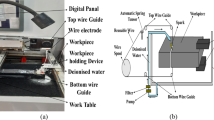Abstract
The SiC reinforced z-pinned composites are becoming advantageous in the field of aerospace and defense sector due to their superior mechanical properties. The reinforcement of SiC particles makes them difficult to machine with conventional machining processes. In the present research investigation, the micro-slicing of SiC reinforced z-pinned composites has been attempted using wire electrochemical discharge machining (WECDM). WECDM is newly emerging technique which combines the process features of electrochemical machining (ECM) and wire electrical discharge machining (WEDM) processes. The experiments were planned using Taguchi’s methodology using L9 Orthogonal array to study the effect of various process parameters i.e. applied voltage, wire feed rate (WFR) and duty cycle on the output quality characteristics such as diametric overcut (DOC) and material removal rate (MRR). The grey relational analysis (GRA) methodology was implemented for multi-response optimization. The diametric overcut and material removal rate of machined samples at optimum parametric conditions of GRA method improves from 71.87 μm to 60.20 μm and 34.20 mg/min to 32.30 mg/min respectively. The morphology of micro-sliced sample using GRA method signifies better quality machined surface with minimization of micro-cracks and uniform cutting.
Similar content being viewed by others
References
Behera BA, Dash BP (2015) Mechanical behavior of 3D woven composites. Mater Des 67:261–271
Mudhukrishnan M, Hariharan P, Palanikumar K (2020) Measurement and analysis of thrust force and delamination in drilling glass fiber reinforced polypropylene composites using different drills. Measurement 149:106973
Singh M, Singh S (2019) Electrochemical discharge machining: a review on preceding and perspective research. Proc Inst Mech Eng B J Eng Manuf 233(5):1425–1449
Liu Y, Wei Z, Wang M, Zhang J (2017) Experimental investigation of micro wire electrochemical discharge machining by using a rotating helical tool. J Manuf Process 29:265–271
Goud M, Sharma AK, Jawalkar C (2016) A review on material removal mechanism in electrochemical discharge machining (ECDM) and possibilities to enhance the material removal rate. Precis Eng 45:1–17
Jain VK, Sreenivasa Rao P, Choudhary SK, Rajurkar KP (1991) Experimental investigations into traveling wire electrochemical spark machining (TW-ECSM) of composites. Journal of Engineering for Industry 113(1):75–84
Peng WY, Liao YS (2004) Study of electrochemical discharge machining technology for slicing non-conductive brittle materials. J Mater Process Technol 149(1–3):363–369
Yang CT, Song SL, Yan BH, Huang FY (2006) Improving machining performance of wire electrochemical discharge machining by adding SiC abrasive to electrolyte. Int J Mach Tools Manuf 46(15):2044–2050
Malik A, Manna A (2016) An experimental investigation on developed WECSM during micro slicing of e-glass fibre epoxy composite. Int J Adv Manuf Technol 85(9–12):2097–2106
Mitra, N.S., Doloi, B. and Bhattacharyya, B., 2015. Predictive analysis of criterial yield during travelling wire electrochemical discharge machining of Hylam based composites. Advances in Production Engineering & Management, 10(2), p.73
Rattan N, Mulik RS (2017) Experimental investigations and multi-response optimization of silicon dioxide (quartz) machining in magnetic field assisted TW-ECSM process. Silicon 9(5):663–673
Oza, A.D., Kumar, A., Badheka, V. and Arora, A., 2019. Traveling wire electrochemical discharge machining (TW-ECDM) of quartz using zinc coated brass wire: investigations on material removal rate and kerf width characteristics. Silicon, pp.1-12
Singh T, Dvivedi A, Arya RK (2019) Fabrication of micro-slits using W-ECDM process with textured wire surface: an experimental investigation on kerf overcut reduction and straightness improvement. Precis Eng 59:211–223
Liu JW, Yue TM, Guo ZN (2009) Wire electrochemical discharge machining of Al2O3 particle reinforced aluminum alloy 6061. Mater Manuf Process 24(4):446–453
Jangra K, Grover S, Aggarwal A (2012) Optimization of multi machining characteristics in WEDM of WC-5.3% co composite using integrated approach of Taguchi, GRA and entropy method. Front Mech Eng 7(3):288–299
Singh S, Singh I, Dvivedi A (2013) Multi objective optimization in drilling of Al6063/10% SiC metal matrix composite based on grey relational analysis. Proc Inst Mech Eng B J Eng Manuf 227(12):1767–1776
Antil P, Singh S, Manna A (2018) Electrochemical discharge drilling of SiC reinforced polymer matrix composite using Taguchi’s grey relational analysis. Arab J Sci Eng 43(3):1257–1266
Thakur, A., Manna, A. and Samir, S., 2019. Multi-response optimization of turning parameters during machining of EN-24 steel with SiC Nanofluids based minimum quantity lubrication. Silicon, pp.1-15
Liu G, Zhang L, Guo L, Liao F, Zheng T, Zhong S (2019) Multi-scale progressive failure simulation of 3D woven composites under uniaxial tension. Compos Struct 208:233–243
Pingkarawat K, Mouritz AP (2016) Comparative study of metal and composite z-pins for delamination fracture and fatigue strengthening of composites. Eng Fract Mech 154:180–190
Antil, P., 2019. Modelling and multi-objective optimization during ECDM of silicon carbide reinforced epoxy composites. Silicon, pp.1-14
Arya RK, Dvivedi A (2019) Investigations on quantification and replenishment of vaporized electrolyte during deep micro-holes drilling using pressurized flow-ECDM process. J Mater Process Technol 266:217–229
Gupta PK, Dvivedi A, Kumar P (2016) Effect of pulse duration on quality characteristics of blind hole drilled in glass by ECDM. Mater Manuf Process 31(13):1740–1748
Author information
Authors and Affiliations
Corresponding authors
Additional information
Publisher’s Note
Springer Nature remains neutral with regard to jurisdictional claims in published maps and institutional affiliations.
Rights and permissions
About this article
Cite this article
Kumar, U., Singh, M. & Singh, S. Wire-Electrochemical Discharge Machining of SiC Reinforced Z-Pinned Polymer Matrix Composite Using Grey Relational Analysis. Silicon 13, 777–786 (2021). https://doi.org/10.1007/s12633-020-00484-4
Received:
Accepted:
Published:
Issue Date:
DOI: https://doi.org/10.1007/s12633-020-00484-4




